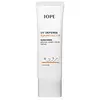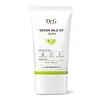What's inside
What's inside
 Key Ingredients
Key Ingredients

 Benefits
Benefits

 Concerns
Concerns

No concerns
 Ingredients Side-by-side
Ingredients Side-by-side

Water
Skin ConditioningButylene Glycol
HumectantHomosalate
Skin ConditioningOctocrylene
UV AbsorberGlycerin
HumectantEthylhexyl Salicylate
UV AbsorberButyloctyl Salicylate
Skin ConditioningButyl Methoxydibenzoylmethane
UV AbsorberCetearyl Alcohol
EmollientPhenyl Trimethicone
Skin ConditioningCaprylyl Methicone
Skin ConditioningPotassium Cetyl Phosphate
EmulsifyingCetearyl Glucoside
Emulsifying1,2-Hexanediol
Skin ConditioningSodium Polyacryloyldimethyl Taurate
Emulsion StabilisingHydroxyethyl Acrylate/Sodium Acryloyldimethyl Taurate Copolymer
Emulsion StabilisingParfum
MaskingTocopherol
AntioxidantGlyceryl Caprylate
EmollientDisodium EDTA
Ethylhexylglycerin
Skin ConditioningLimonene
PerfumingSorbitan Isostearate
EmulsifyingLinalool
PerfumingGlucose
HumectantCitronellol
PerfumingHexyl Cinnamal
PerfumingFerulic Acid
AntimicrobialWater, Butylene Glycol, Homosalate, Octocrylene, Glycerin, Ethylhexyl Salicylate, Butyloctyl Salicylate, Butyl Methoxydibenzoylmethane, Cetearyl Alcohol, Phenyl Trimethicone, Caprylyl Methicone, Potassium Cetyl Phosphate, Cetearyl Glucoside, 1,2-Hexanediol, Sodium Polyacryloyldimethyl Taurate, Hydroxyethyl Acrylate/Sodium Acryloyldimethyl Taurate Copolymer, Parfum, Tocopherol, Glyceryl Caprylate, Disodium EDTA, Ethylhexylglycerin, Limonene, Sorbitan Isostearate, Linalool, Glucose, Citronellol, Hexyl Cinnamal, Ferulic Acid
Water
Skin ConditioningZinc Oxide
Cosmetic ColorantPropanediol
SolventButyloctyl Salicylate
Skin ConditioningPropylheptyl Caprylate
EmollientCoco-Caprylate/Caprate
EmollientCyclohexasiloxane
EmollientCaprylyl Methicone
Skin ConditioningIsododecane
EmollientLauryl Polyglyceryl-3 Polydimethylsiloxyethyl Dimethicone
Skin ConditioningMethyl Trimethicone
Skin ConditioningMethyl Methacrylate Crosspolymer
Disteardimonium Hectorite
StabilisingMagnesium Sulfate
Triethoxycaprylylsilane
1,2-Hexanediol
Skin ConditioningPolyglyceryl-2 Dipolyhydroxystearate
Skin ConditioningPolymethylsilsesquioxane
Glyceryl Caprylate
EmollientCaprylyl Glycol
EmollientEthylhexylglycerin
Skin ConditioningSodium Hyaluronate
HumectantButylene Glycol
HumectantTocopherol
AntioxidantCentella Asiatica Extract
CleansingCaesalpinia Spinosa Fruit Extract
Skin ProtectingPinus Pinaster Bark Extract
AntioxidantKappaphycus Alvarezii Extract
Skin Conditioning7-Dehydrocholesterol
Emulsion StabilisingHouttuynia Cordata Extract
Skin ConditioningEctoin
Skin ConditioningBuddleja Officinalis Flower Extract
UV FilterLactobacillus Ferment
Skin ConditioningHydroxycinnamic Acid
Skin ConditioningRutin
AntioxidantWater, Zinc Oxide, Propanediol, Butyloctyl Salicylate, Propylheptyl Caprylate, Coco-Caprylate/Caprate, Cyclohexasiloxane, Caprylyl Methicone, Isododecane, Lauryl Polyglyceryl-3 Polydimethylsiloxyethyl Dimethicone, Methyl Trimethicone, Methyl Methacrylate Crosspolymer, Disteardimonium Hectorite, Magnesium Sulfate, Triethoxycaprylylsilane, 1,2-Hexanediol, Polyglyceryl-2 Dipolyhydroxystearate, Polymethylsilsesquioxane, Glyceryl Caprylate, Caprylyl Glycol, Ethylhexylglycerin, Sodium Hyaluronate, Butylene Glycol, Tocopherol, Centella Asiatica Extract, Caesalpinia Spinosa Fruit Extract, Pinus Pinaster Bark Extract, Kappaphycus Alvarezii Extract, 7-Dehydrocholesterol, Houttuynia Cordata Extract, Ectoin, Buddleja Officinalis Flower Extract, Lactobacillus Ferment, Hydroxycinnamic Acid, Rutin
 Reviews
Reviews

Ingredients Explained
These ingredients are found in both products.
Ingredients higher up in an ingredient list are typically present in a larger amount.
1,2-Hexanediol is a synthetic liquid and another multi-functional powerhouse.
It is a:
- Humectant, drawing moisture into the skin
- Emollient, helping to soften skin
- Solvent, dispersing and stabilizing formulas
- Preservative booster, enhancing the antimicrobial activity of other preservatives
Butylene Glycol (or BG) is used within cosmetic products for a few different reasons:
Overall, Butylene Glycol is a safe and well-rounded ingredient that works well with other ingredients.
Though this ingredient works well with most skin types, some people with sensitive skin may experience a reaction such as allergic rashes, closed comedones, or itchiness.
Learn more about Butylene GlycolButyloctyl Salicylate is a chemical UV filter structurally similar to octisalate. It is a photostabilizer, SPF booster, emollient and solvent. This ingredient helps evenly spread out ingredients.
According to a manufacturer, it is suitable for pairing with micro Titanium Dioxide, Zinc Oxide, and pigments.
Photostabilizers help stabilize UV-filters and prevents them from degrading quickly.
Learn more about Butyloctyl SalicylateCaprylyl Methicone is a type of silicone.
It helps soften and soothe the skin by creating a thin film on top. This film helps trap moisture, keeping your skin hydrated.
Ethylhexylglycerin (we can't pronounce this either) is commonly used as a preservative and skin softener. It is derived from glyceryl.
You might see Ethylhexylglycerin often paired with other preservatives such as phenoxyethanol. Ethylhexylglycerin has been found to increase the effectiveness of these other preservatives.
Glyceryl Caprylate comes from glycerin and caprylic acid, a fatty acid from coconut. It has emollient and emulsifier properties.
As an emollient, it helps hydrate your skin. Emollients work by creating a barrier on your skin to trap moisture in, helping to keep your skin soft and smooth.
On the other hand, emulsifiers prevent ingredients (such as oil and water) from separating.
Learn more about Glyceryl CaprylateTocopherol (also known as Vitamin E) is a common antioxidant used to help protect the skin from free-radicals and strengthen the skin barrier. It's also fat soluble - this means our skin is great at absorbing it.
Vitamin E also helps keep your natural skin lipids healthy. Your lipid skin barrier naturally consists of lipids, ceramides, and fatty acids. Vitamin E offers extra protection for your skin’s lipid barrier, keeping your skin healthy and nourished.
Another benefit is a bit of UV protection. Vitamin E helps reduce the damage caused by UVB rays. (It should not replace your sunscreen). Combining it with Vitamin C can decrease sunburned cells and hyperpigmentation after UV exposure.
You might have noticed Vitamin E + C often paired together. This is because it is great at stabilizing Vitamin C. Using the two together helps increase the effectiveness of both ingredients.
There are often claims that Vitamin E can reduce/prevent scarring, but these claims haven't been confirmed by scientific research.
Learn more about TocopherolWater. It's the most common cosmetic ingredient of all. You'll usually see it at the top of ingredient lists, meaning that it makes up the largest part of the product.
So why is it so popular? Water most often acts as a solvent - this means that it helps dissolve other ingredients into the formulation.
You'll also recognize water as that liquid we all need to stay alive. If you see this, drink a glass of water. Stay hydrated!
Learn more about Water